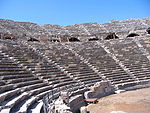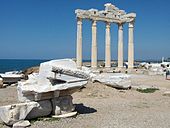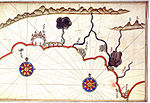Side, Turkey: Difference between revisions
Doug Weller (talk | contribs) Reverted 2 edits by 204.96.142.5 (talk); No justification given for change. using TW |
→Today: Sources added |
||
| Line 67: | Line 67: | ||
==Today== |
==Today== |
||
In 1895 [[Turkish]] [[Muslim]]<ref>[http://www.tripwiser.com/trip_destination-Turkey_Side?itiNodeId=8a8c80fe152a92f401152b790eba13ae&eType=site] From link: In 1895 Turkish people from Crete moved to the ruined town and called it Selimiye.</ref><ref>[http://www.travel-library.com/europe/turkey/side/]Side Travel Guide</ref><ref>[http://turkey.1stpage.biz/side.asp]Turkish Riviera - Side</ref><ref>[http://www.tuerkei-ferien.de/tuerkei/side.htm](german) Google translation of relevant part: In 1895 Turkish settlers came from Crete and settled at the tip of the peninsula, the harbor and the surrounding area down.=Im Jahr 1895 kamen türkische Siedler aus Kreta und ließen sich an der Spitze der Halbinsel, am Hafen und seiner Umgebung, nieder.</ref><ref>[http://www.side-info.de/6587/34617.html?*session*id*key*=*session*id*val*](german) Google translation of relevant part: Erst 1895 wurde die Halbinsel von türkischen Aussiedlern aus Kreta wieder besiedelt.=In 1895 the peninsula was repopulated by Turkish immigrants from Crete.</ref><ref>[http://www.sidestarreiseclub.de/index.php?option=com_content&view=article&id=10:ihr-urlaubsort-side&catid=9:info-region&Itemid=10]Google translation of relevant part: In 1895 Turkish settlers came from Crete and settled at the tip of the peninsula, the harbor and the surrounding area down.= Im Jahr 1895 kamen türkische Siedler aus Kreta und ließen sich an der Spitze der Halbinsel, am Hafen und seiner Umgebung, nieder.</ref><ref>[http://www.rp-online.de/reise/TuerkeiTurteln-unter-Tempelsaeulen_aid_13714.html](german newssite)Google translation of relevant part: 1895 rediscovered by Turks originally from Creta;= |
|||
1895 wiederentdeckt von ursprünglich auf Kreta ansässigen Türken;</ref> refugees from [[Crete]] moved to the ruined town and called it Selimiye. Today, Side has become a popular vacation destination and experiences a new revival. |
|||
It was a popular spot for watching the [[Solar eclipse of 2006 March 29|solar eclipse of March 29, 2006]]. |
It was a popular spot for watching the [[Solar eclipse of 2006 March 29|solar eclipse of March 29, 2006]]. |
||
Revision as of 13:51, 30 December 2010

Side (Greek: Σίδη Side, Turkish: Side) was an ancient Greek city in Anatolia, in the region of Pamphylia, in what is now Antalya province, on the southern Mediterranean coast of Turkey. It is now a resort town and one of the best-known classical sites in Turkey, near Manavgat and the village of Selimiye, 75 km from Antalya) in the province of Antalya.[1]
It is located on the eastern part of the Pamphylian coast, which lies about 20 km east of the mouth of the Eurymedon River. Today, as in antiquity, the ancient city is situated on a small north-south peninsula about 1 km long and 400 m across.
History

Strabo and Arrian both record that Side was founded by Greek settlers from Cyme in Aeolis, a region of western Anatolia. This most likely occurred in the 7th century B.C. Possessing a good harbor for small-craft boats, Side's natural geography made it one of the most important places in Pamphylia and one of the most important trade centers in the region. According to Arrian, when settlers from Cyme came to Side, they could not understand the dialect. After a short while, the influence of this indigenous tongue was so great that the newcomers forgot their native Greek and started using the language of Side. Excavations have revealed several inscriptions written in this language. The inscriptions, dating from the 3rd and 2nd centuries B.C., remain undeciphered, but testify that the local language was still in use several centuries after colonization. Another object found in the excavations at Side, a basalt column base from the 7th century B.C. and attributable to the Neo-Hittites, provides further evidence of the site's early history. The name Side is Anatolian in origin and means pomegranate.
Next to no information exists concerning Side under Lydian and Persian sovereignty.
Alexander the Great
Alexander the Great occupied Side without a struggle in 333 BC. Alexander left only a single garrison behind to occupy the city. This occupation, in turn, introduced the people of Side to Hellenistic culture, which flourished from the 4th to the 1st century BC. After Alexander's death, Side fell under the control of one of Alexander's generals, Ptolemy I Soter, who declared himself king of Egypt in 305 BC. The Ptolemaic dynasty controlled Side until it was captured by the Seleucid Empire in the 2nd century BC. Yet, despite these occupations, Side managed to preserve some autonomy, grew prosperous, and became an important cultural center.
In 190 BC a fleet from the Greek island city-state of Rhodes, supported by Rome and Pergamum, defeated the Seleucid King Antiochus the Great's fleet, which was under the command of the fugitive Carthaginian general Hannibal. The defeat of Hannibal and Antiochus the Great meant that Side freed itself from the overlordship of the Seleucid Empire. The Treaty of Apamea (188 BC) forced Antiochus to abandon all European territories and to cede all of Asia Minor north of the Taurus Mountains to Pergamum. However, the dominion of Pergamum only reached de facto as far as Perga, leaving Eastern Pamphylia in a state of uncertain freedom. This led Attalus II Philadelphus to construct a new harbour in the city of Attalia (the present Antalya), although Side already possessed an important harbour of its own. Between 188 and 36 BC Side minted its own money, tetradrachms showing Nike and a laurel wreath (the sign of victory).
In the 1st century BC, Side reached a peak when the Cilician pirates established their chief naval base and a centre for their slave-trade.
Romans

The consul Servilius Vatia defeated these brigands in 78 BC and later the Roman general Pompey in 67 BC, bringing Side under the control of Rome and beginning its second period of ascendancy, when it established and maintained a good working relationship with the Roman Empire.[2]

Emperor Augustus reformed the state administration and placed Pamphylia and Side in the Roman province of Galatia in 25 BC, after the short reign of Amyntas of Galatia between 36 and 25 BC. Side began another prosperous period as a commercial center in Asia Minor through its trade in olive oil. Its population grew to 60,000 inhabitants. This period would last well into the 3rd century AD. Side also established itself as a slave-trading center in the Mediterranean. Its large commercial fleet engaged in acts of piracy, while wealthy merchants paid for such tributes as public works, monuments, and competitions as well as the games and gladiator fights. Most of the extant ruins at Side date from this period of prosperity.
Decline
Side began a steady decline from the 4th century on. Even defensive walls could not stop successive invasions of highlanders from the Taurus Mountains. During the 5th and 6th centuries, Side experienced a revival, and became the seat of the Bishopric of Eastern Pamphylia. Arab fleets, nevertheless, raided and burned Side during the 7th century, contributing to its decline. The combination of earthquakes, Christian zealots and Arab raids, left the site abandoned by the 10th century, its citizens having emigrated to nearby Antalya.[2]
In the 12th century, Side temporarily established itself once more as a large city. An inscription found on the site of the former ancient city shows a considerable Jewish population in early Byzantine times. However, Side was abandoned again after being sacked. Its population moved to Antalya, and Side became known as Eski Adalia ("Old Antalya") and was buried.
Historical Maps

Ruins

The great ruins are among the most notable in Asia Minor. They cover a large promontory where a wall and a moat separate it from the mainland. During medieval times, the wall and moat were repaired and the promontory houses a wealth of structures.
There are colossal ruins of a theater complex, the largest of Pamphylia, built much like a Roman amphitheater that relies on arches to support the sheer verticals. The Roman style was adopted because Side lacked a convenient hillside that could be hollowed out in the usual Greek fashion more typical of Asia Minor. The theater is less preserved than the theater at Aspendos, but it is almost as large, seating 15,000 - 20,000 people. With time and the shifting of the earth, the scena wall has collapsed over the stage and the proscenium is in a cataract of loose blocks. It was converted into an open-air sanctuary with two chapels during Byzantine times (5th-6th c.) Close

The well-preserved city walls provide an entrance to the site through the Hellenistic main gate (Megale Pyle) of the ancient city, although this gate from the 2nd century BC is badly damaged. Next comes the colonnaded street, whose marble columns are no longer extant; all that remains are a few broken stubs near the old Roman baths. The street leads to the a public bath, restored as a museum displaying statues and sarcophagi from the Roman period. Next is the square agora with the remains of the round Tyche and Fortuna temple (2nd c. BC), a periptery with twelve columns, in the middle. In later times it was used as a trading center where pirates sold slaves. The remains of the theatre, which was used for gladiator fights and later as a church, and the monumental gate date back to the 2nd century. The early Roman Temple of Dionysus is near the theater. The fountain gracing the entrance is restored. At the left side are the remains of a Byzantine Basilica. A public bath has also been restored.[2]
The remaining ruins of Side include three temples, an aqueduct, and a nymphaeum. Side's nymphaeum – a grotto with a natural water supply dedicated to the nymphs – was an artificial grotto or fountain building of elaborate design.
Turkish archaeologists have been excavating Side since 1947 and intermittently continue to do so.[3]
Today
In 1895 Turkish Muslim[4][5][6][7][8][9][10] refugees from Crete moved to the ruined town and called it Selimiye. Today, Side has become a popular vacation destination and experiences a new revival.
It was a popular spot for watching the solar eclipse of March 29, 2006.
Having been the Bishopric of Eastern Pamphylia, it is still a titular see of the Roman Catholic church.
See also
- Coinage of Side
- Manavgat Waterfall
- Oymapinar Dam
- Philip of Side
- Saint Probus of Side
- Sidetic language
Notes
- ^ "The Ancient Library". Retrieved 2006-11-19.
- ^ a b c "Side - History of the City". Retrieved 2006-11-19.
- ^ "Aspendos - Perge - Side". Retrieved 2006-11-19.
- ^ [1] From link: In 1895 Turkish people from Crete moved to the ruined town and called it Selimiye.
- ^ [2]Side Travel Guide
- ^ [3]Turkish Riviera - Side
- ^ [4](german) Google translation of relevant part: In 1895 Turkish settlers came from Crete and settled at the tip of the peninsula, the harbor and the surrounding area down.=Im Jahr 1895 kamen türkische Siedler aus Kreta und ließen sich an der Spitze der Halbinsel, am Hafen und seiner Umgebung, nieder.
- ^ [5](german) Google translation of relevant part: Erst 1895 wurde die Halbinsel von türkischen Aussiedlern aus Kreta wieder besiedelt.=In 1895 the peninsula was repopulated by Turkish immigrants from Crete.
- ^ [6]Google translation of relevant part: In 1895 Turkish settlers came from Crete and settled at the tip of the peninsula, the harbor and the surrounding area down.= Im Jahr 1895 kamen türkische Siedler aus Kreta und ließen sich an der Spitze der Halbinsel, am Hafen und seiner Umgebung, nieder.
- ^ [7](german newssite)Google translation of relevant part: 1895 rediscovered by Turks originally from Creta;= 1895 wiederentdeckt von ursprünglich auf Kreta ansässigen Türken;
External links
- Side and Manavgat - About Side and Manavgat
- Side photos with explanations
- Hazlitt, Classical Gazetteer, "Side"
- Pictures of Side Greek Ruins
This article incorporates text from a publication now in the public domain: Chisholm, Hugh, ed. (1911). Encyclopædia Britannica (11th ed.). Cambridge University Press. {{cite encyclopedia}}: Missing or empty |title= (help)
